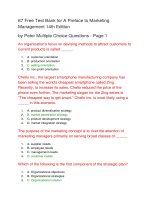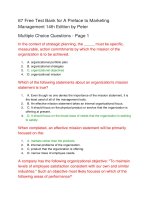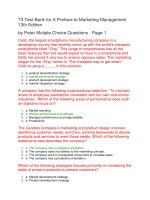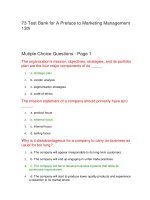Test bank of fred r david – strategic management, 13th edition ch5
Bạn đang xem bản rút gọn của tài liệu. Xem và tải ngay bản đầy đủ của tài liệu tại đây (105.16 KB, 33 trang )
Exam
Name___________________________________
TRUE/FALSE. Write 'T' if the statement is true and 'F' if the statement is false.
1)
Firms face complex and challenging factors in competing globally.
1)
_______
2)
Arab-based companies have been aggressively venturing abroad for 30 years now.
2)
_______
3)
Governments in various parts of the world have relaxed market regulations and accelerated privatization
of state-owned companies.
3)
_______
4)
In recent years, Arab executives have not considered international and global business involvement to be a
strategic choice essential for growth and development.
4)
_______
5)
Arab executives from Morocco to Oman have intended to expand their business to international markets.
5)
_______
6)
Market expansion allows companies to realize an economy of scale.
6)
_______
7)
Despite their accessibility to capital or a greater amount of liquidity, the companies in the Gulf region fail
to seize opportunities.
7)
_______
8)
Increasing competition, and the willingness of many Arab executives, has induced many companies to
expand overseas.
8)
_______
9)
One of the reasons why Arab executives have set their eyes on expanding beyond domestic and regional
markets is to capitalize on core competencies.
9)
_______
10)
Major Arab companies have recognized the need to sustain their competitiveness and meet their
competitors on similar fronts.
10)
______
11)
In 2009, Advanced Technology Investment Company of Abu Dhabi acquired Singapore’s Chartered
Semiconductor Manufacturing.
11)
______
12)
Planet Food World, a Saudi based company, has invested heavily in agriculture products, mainly industrial
farms, in Turkey.
12)
______
13)
Arab countries rarely vary in their commitment to international expansion and activities.
13)
______
14)
Up to the early 1970s, most Arab business people served as representatives of, and/or distributors for
major multinational corporations.
14)
______
15)
The globalization focus ignores the global market as the platform for action.
15)
______
16)
In the process of globalization, the activities and involvement of the firms are determined by opportunities.
16)
______
17)
Both internationalization and global approaches have been essential in enabling Arab business to leave
their mark on the world economy.
17)
______
18)
Arab companies are confronted with various issues as part of their global expansion.
18)
______
19)
The methods of tackling various issues due to global expansion are product of a single factor.
19)
______
20)
In today’s business, executives have ample access to information provided by various sources.
20)
______
21)
The World Factbook includes information related to the history, people, government, economy, geography,
communications, transportation, military, and transnational issues of 266 nation states.
21)
______
22)
It is not so important for Arab executives to monitor global trends as long as they are familiar with general
and economic conditions of the target country or region.
22)
______
23)
Regardless of which country a company chooses to operate in, its executives must understand that
differences do exist and must be approached with an open mind.
23)
______
24)
Demographically, while some countries have experienced an acute shortage in youth population, the Arab
world has a high ratio of youth.
24)
______
25)
The IMF divides the world into three major groups advanced economies, old economies, and
emerging/developing economies.
25)
______
26)
The share of the United States in world exports of goods and services is 9.9 percent, while that of subSaharan Africa (44 countries) is over 20 percent.
26)
______
27)
The economic growth in China and India, along with other emerging economies, especially Russia and
Brazil, is expected to fuel world economic growth.
27)
______
28)
With 60 percent of the world's population spread out over three continents, BRIC already accounts for 35
percent of global GDP.
28)
______
29)
The growth of other emerging and developing economies was impressive as economically advanced
countries struggled with the 2008 financial crisis.
29)
______
30)
Emerging economies are becoming less and less important as they no longer offer attractive investment
opportunities for global retailers.
30)
______
31)
The Global Retail Development Index 2009 suggests that many Arab states have joined the ranks of the
major emerging market countries.
31)
______
32)
As cultural and economic differences always exist among countries, Arab executives have had to give-up
surveillance and alert systems.
32)
______
33)
In a world where global presence has become essential, Arab firms have no choice but to position
themselves strategically.
33)
______
34)
There are hundreds of markets, but which markets to focus on is a strategic decision that should top the
marketing manager's list of priorities.
34)
______
35)
Gupta and Govindarajan suggested that companies should engage in "directed opportunism" or
opportunism led by a systematic and logical framework.
35)
______
36)
When companies have multiproduct or multiple business units, the market might be attractive for a
particular product or business but not for others.
36)
______
37)
Market entry strategies rarely differ across industries and target markets.
37)
______
38)
Angela Martins, international director of Banco ABC Brasil, states that Brazil's growth is easy for Arab realestate investors to ignore.
38)
______
39)
Export is the newest and possibly the least risky approach to foreign market expansion.
39)
______
40)
Modern Arab firms in the early twentieth century, especially from Syria and Lebanon, were pioneers in
export business.
40)
______
41)
Under a franchising agreement, McDonalds or Hilton might supply a local businessman in Cairo with its
intangible property and operational knowledge.
41)
______
42)
Unlike licensing, franchising gives the franchiser more say in how the business should operate.
42)
______
43)
Contract manufacturing gives the company the opportunity to increase its foreign investment.
43)
______
44)
In 2005, UNESCO reported that the Arab world has spent U.S. $1,000 billion on turnkey projects in the past
three decades.
44)
______
45)
Joint ventures with governments are often a good way to establish efficient operations.
45)
______
46)
Companies utilize different modes for entering into a market and, depending on the situation, can use
multiple modes simultaneously.
46)
______
47)
Trade openness and the liberalization process, along with increasing numbers of MNCs from the nonWestern world, have changed the nature of competition in the world market.
47)
______
48)
In the global marketplace, strategy is not a vital instrument for competitively positioning a company.
48)
______
49)
Multidomestic strategy is a strategic approach where the subsidiary company allows its parent company to
decide how to compete in various markets.
49)
______
50)
As companies operate globally, they utilize their production capacity and achieve lower production costs.
50)
______
51)
Arab firms have many global brands.
51)
______
52)
Recently, Saudi Arabia took the initiative in establishing several knowledge cities across the country.
52)
______
53)
A global strategy is simply the leveraging of benefits of the firm’s country of origin.
53)
______
54)
Porter argues that the scale of a firm used to be important for Arab firms to compete globally but this is no
longer the case in a globalized market.
54)
______
55)
Achieving superior performance relative to competitors requires an establishment and sustained
comparative position over rivals, including domestic firms.
55)
______
56)
The key to successful global strategy is to manage the interactions between the different goals and means.
56)
______
57)
Companies are endowed with various different capabilities and resources, and when they operate overseas
they are confronted with complex factors and demands.
57)
______
58)
Instead of making efforts to adjust to differences in foreign markets, companies will often exploit those
differences in order to create opportunities.
58)
______
59)
The expansion of Arab companies into global markets constitutes an opportunity for growth and learning.
59)
______
60)
The expansion of Arab companies into global markets eases prevailing management practices.
60)
______
61)
There are many very large Arab firms operating globally.
61)
______
62)
In the near future, more Arab corporations will expand their markets into Asia, Africa, Europe, and other
regions.
62)
______
63)
Arab corporations have to rethink their roles globally and embark on strategic initiatives to seize global
opportunities.
63)
______
64)
Arab corporations should not study the strategic approaches of their counterparts in emerging countries
because those counterparts have found it hard to acheive success.
64)
______
MULTIPLE CHOICE. Choose the one alternative that best completes the statement or answers
the question.
65)
Prior to the last twenty years, the involvement of Arab firms in the global market place were primarily
limited to specific sectors that include
65)
______
A)
energy, petrochemicals, and trade.
B)
energy, petrochemicals, and transportation .
C)
energy, trade, and transportation.
D)
energy, transportation, and space.
66)
The various reasons why Arab executives from Morocco to Oman are interested in expanding beyond
domestic and regional markets include
66)
______
A)
new market exploration.
B)
technology advancement.
C)
accessibility to low cost materials.
D)
market expansion.
E)
all the above
67)
The major Arab companies that have established a presence in attractive markets in emerging economies
and the western world are
67)
______
A)
Aramco, EPCO, and the National Bank of Kuwait.
B)
Aramco, ADNOC, and the National Bank of Kuwait.
C)
Aramco, SABIC, and the National Bank of Kuwait.
D)
Aramco, Qatar Petrochemicals, and the National Bank of Kuwait.
68)
Two strategic focal points for expansion are
68)
______
A)
globalization and privatization.
B)
globalization and nationalization.
C)
globalization and localization.
D)
globalization and internationalization.
69)
The ________ is limited to expansion to a few countries.
69)
______
A)
vertical integration strategy
B)
global strategy
C)
international strategy
D)
low-cost leader strategy
70)
Executives who subscribe to ________ orientations tend to project the beliefs and values of the parent
company on its subsidiaries and offices abroad.
70)
______
A)
regiocentric
B)
polycentric
C)
geocentric
D)
ethnocentric
E)
None of the above
71)
Executives who consider the culture of the host country as appropriate to guide the operation and decision
making are from ________ orientations.
71)
______
A)
regiocentric
B)
geocentric
C)
polycentric
D)
ethnocentric
E)
All of the above
72)
Under ________ orientations, executives are guided by the best practice globally and tend to prefer an
integrated approach to managing operations.
72)
______
A)
regiocentric
B)
polycentric
C)
geocentric
D)
ethnocentric
E)
None of the above
73)
Managers, who subscribe to ________ orientations, find it useful to let the general beliefs and values
prevailing in a particular region guide the operations there.
73)
______
A)
regiocentric
B)
polycentric
C)
ethnocentric
D)
geocentric
E)
All of the above
74)
The following UN agencies provide detailed and relevant information about conditions in many countries
74)
______
A)
World Health Organization (WHO), World Trade Organization (WTO), and World Bank
B)
World Bank, World Trade Organization (WTO), and International Monetary Fund (IMF)
C)
World Bank, World Health Organization (WHO), and International Monetary Fund (IMF)
D)
World Health Organization (WHO), World Trade Organization (WTO), and International Monetary Fund (IMF)
75)
Which of the following is not a global trend that was specified in the Mckinsey & Company study?
75)
______
A)
A growing number of consumers in emerging economies.
B)
Growth of public sector.
C)
Growing global demographic trends.
D)
Increasingly global labor and talent markets.
E)
Increasing constraints in supply or usage of natural resources.
76)
Which global trends should be integrated into strategic planning?
76)
______
A)
The increasing influence of emerging economies in the global marketplace, and the growth of the public
sector.
B)
The growth of the public sector, and integration in business and social realms.
C)
The increasing influence of emerging economies in the global marketplace, and increasingly global labor
and talent markets.
D)
The influence of emerging economies in the global marketplace, and interaction in business and social
realms.
77)
Investing in emerging economies can bring what immediate benefits to Arab businesses?
77)
______
A)
increasing communication and greater ease of obtaining and developing knowledge.
B)
Application of scientific techniques and approaches to business management.
C)
Diversification of portfolios, and access to natural resources and untapped markets.
D)
Diversification of portfolios and greater ease of obtaining and developing knowledge.
78)
From Brazil to Japan, and from Spain to China, cultural differences are apparent in religious beliefs and
78)
______
A)
regard for time and work.
B)
dress.
C)
eating habits.
D)
personal interaction.
E)
all the above
79)
Firms in the Gulf Cooperation Council (GCC) states lack a competitive advantage when positioning
themselves strategically. This is due to
79)
______
A)
a shortage of qualified manpower .
B)
an inability to deal with staggering opportunities.
C)
an inability to project the global market growth.
D)
inadequate ability to exploit the market.
80)
Gupta and Govindarajan suggested which of the following as a choice available for companies considering
entering a foreign market?
80)
______
A)
Establish reasonable foothold
B)
Gradual entry
C)
Disregard for now
D)
Rapid entry
E)
All the above
81)
Which city is not a popular choice among international property investors scouting for locations to build a
signature office tower?
81)
______
A)
Guatemala city
B)
Mexico city
C)
Panama city
D)
New York city
82)
Which of the following is not a way of entering foreign markets?
82)
______
A)
Investment
B)
Merging
C)
Contractual approaches
D)
Exporting
83)
The oldest and possibly the least risky approach to foreign market expansion is
83)
______
A)
turnkey operations.
B)
licensing.
C)
franchising.
D)
export.
84)
In the last three decades, many Arab firms have utilized ________ as an ideal way to enter international
markets and accumulate experience abroad
84)
______
A)
turnkey operations.
B)
licensing.
C)
export.
D)
joint venture.
85)
Which of the following is not an advantage of export?
85)
______
A)
It is easy to carry out without investing scarce resources.
B)
The company has full ownership of profits.
C)
It is low-cost and low-risk.
D)
It is easy to arrange suitable distribution channels.
86)
Which type of agreement represents a producer giving the rights of their intellectual property in return for
royalties?
86)
______
A)
Turnkey operations
B)
Licensing
C)
Franchising
D)
Export
87)
Which of the following is common in manufacturing, especially where brand is important?
87)
______
A)
Franchising
B)
Export
C)
Licensing
D)
Management contract
E)
All of the above
88)
Which type of agreement involves a firm granting the right to another entity to run its business in a
specified manner and provide assistance during the contract duration?
88)
______
Export
A)
B)
Franchising
C)
Licensing
D)
Turnkey operations
89)
Which type of agreement has increased steadily in the Arab world since governments in the region have
embarked on liberalization programs?
89)
______
A)
Turnkey operations
B)
Export
C)
Licensing
D)
Franchising
E)
Both B and D
90)
Which type of business involves a contractual agreement for a company to provide management services
and expertise to another company for a determined period?
90)
______
A)
licensing
B)
franchising
C)
management contract
D)
export
E)
None of the above
91)
Which option gives the company the opportunity to reduce its foreign investment and in the process
enables it to have control over its product?
91)
______
A)
Licensing
B)
Franchising
C)
Contract manufacturing
D)
Turnkey operations
E)
Both A and B
92)
In March 2010 the Egypt-based Eastern Company, a cigarette manufacturer, signed a contract with
Jordan's Tag Company to produce, market, and distribute Eastern's products in Jordan. This is an example
of
92)
______
A)
exportation.
B)
franchising.
C)
licensing.
D)
contract manufacturing.
93)
When a company constructs an entire project for the host country organization, this is called
93)
______
A)
franchising.
B)
licensing.
C)
contract manufacturing.
D)
a turnkey operation.
94)
Which type of operation enables clients to have access to hard-to-get skills and technology?
94)
______
A)
Turnkey operation
B)
Franchising
C)
Licensing
D)
Contract manaufacturing
95)
In the global marketplace, joint ventures are established for various reasons, including
95)
______
A)
gaining access to new technology or resources.
B)
reducing risk and achieving a competitive position.
C)
ease in entering and gaining knowledge of foreign markets.
D)
complying with government regulations.
E)
all the above
96)
In 2006, Dubai Ports World bought the British shipping and logistics firm, Peninsular and Oriental Steam
Navigation Company. What is this an example of?
96)
______
A)
Establilshing a wholly owned subsidiary
B)
A joint venture
C)
Licensing
D)
A turnkey operation
97)
When a firm utilizes its entire worldwide system of production and market position against competition, it
is using a
97)
______
A)
global strategy.
B)
international strategy.
C)
transnational strategy.
D)
multidomestic strategy.
98)
Companies are influenced by which two primary factors in deciding what strategy should be chosen?
98)
______
A)
Global market position and national responsiveness.
B)
National market position and global responsiveness.
C)
National integration and global responsiveness.
D)
Global integration and national responsiveness.
99)
Whichof the following is not a mechanism for achieving competitive advantage?
99)
______
A)
Scale economies
B)
Economies of scope
C)
National differences
D)
National economies
100)
Which of the following is not a type of global strategy?
100)
_____
A)
Arbitrage
B)
Aggregation
C)
Agitation
D)
Adaptation
101)
The global strategy that seeks to boost revenues and market share by maximizing the company's local
importance is called
101)
_____
A)
arbitrage.
B)
agitation.
C)
aggregation.
D)
adaptation.
102)
The global strategy that attempts to achieve economies of scale by creating regional or sometimes global
operations is called
102)
_____
A)
arbitrage.
B)
aggregation.
C)
agitation.
D)
adaptation.
103)
Which of the following is not something that a company should consider before pursuing a particular
strategy?
103)
_____
A)
Whether the new elements of a strategy are a good fit for the organization.
B)
Internalization of segregation.
C)
How to apply integration mechanisms in order to match people to jobs.
D)
Externalization of integration.
ESSAY. Write your answer in the space provided or on a separate sheet of paper.
104)
What are the two trends that help pave the way for emerging Arab firms to navigate world markets?
105)
How do The World Factbook and various publications of the UN agencies provide assistance to businesses
towards global expansion and orientation?
106)
List the ten global trends specified by the global consulting firm, McKinsey & Company, in their 2006 study.
107)
Explain why executives must understand the differences between individual countries.
108)
What are the choices available for Arab firms when selecting strategic markets?
109)
Describe the market entry strategies.
110)
What are the activities that Arab companies have to undertake to build sound foundations, expand market
share, and best face the global challenge?
111)
Explain how Arab firms can approach global integration.
1)
TRUE
2)
FALSE
3)
TRUE
4)
FALSE
5)
TRUE
6)
TRUE
7)
FALSE
8)
TRUE
9)
TRUE
10)
FALSE
11)
TRUE









